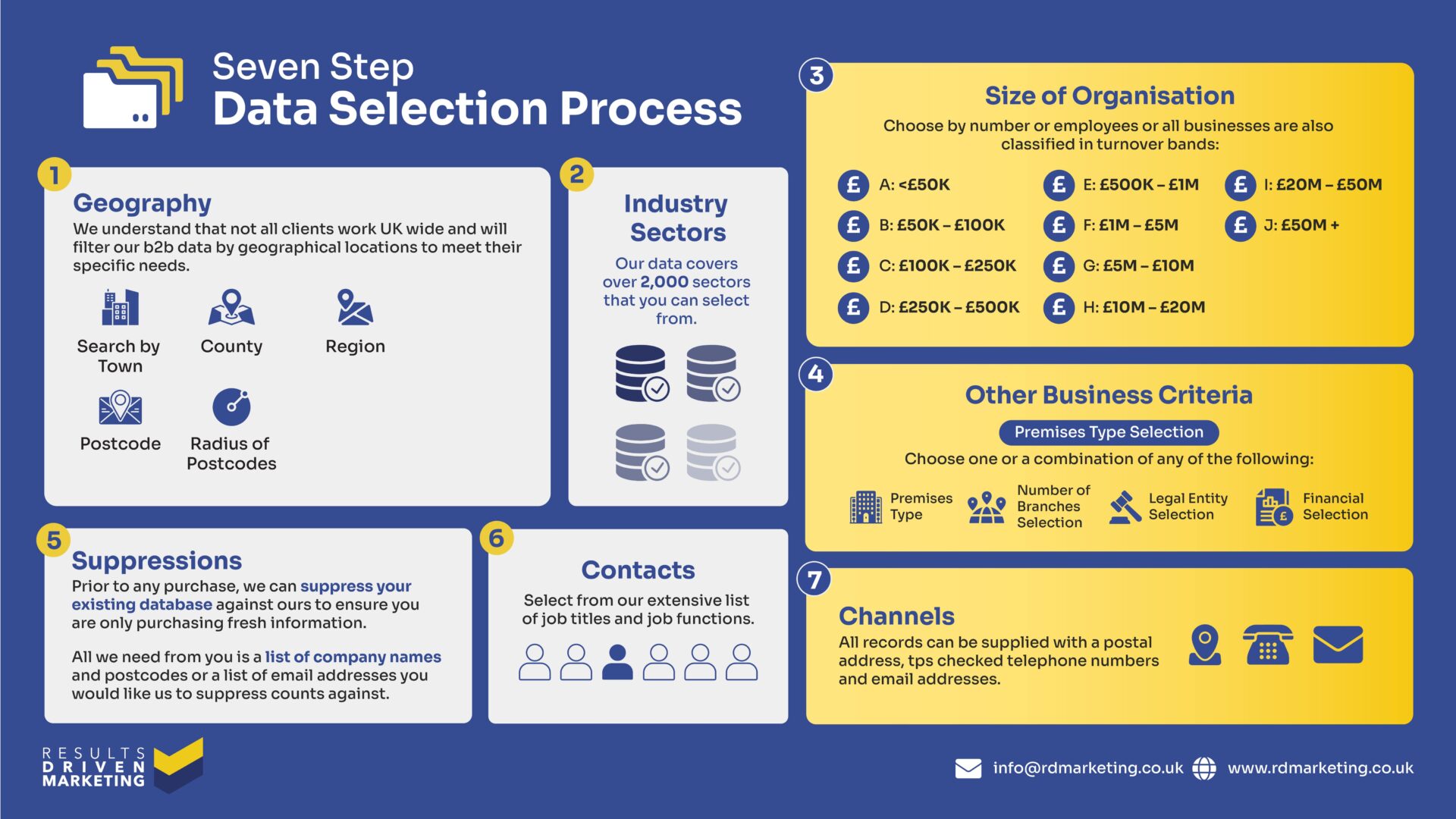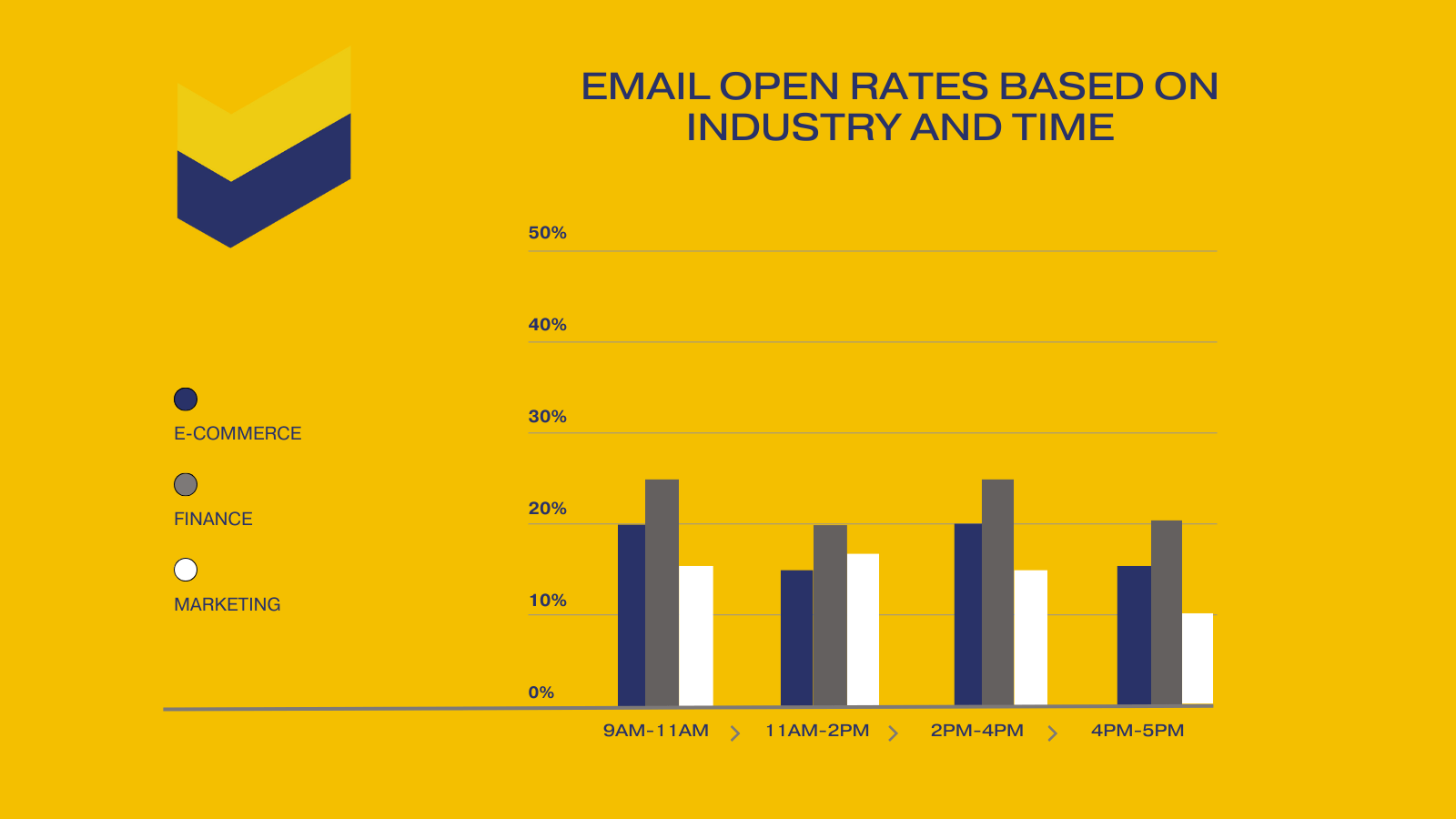
Database of UK Schools
If you’re exploring how to reach decision-makers in the education sector, a database of UK schools is one of the most effective starting points. It gives you targeted access to primary schools, secondary schools, academies, and more—so you’re not just marketing blindly, you’re putting your message in front of the right people.
This kind of data is particularly useful for businesses that sell educational tools, edtech, training, classroom supplies, cleaning services, and other B2B products or services aimed at schools. But here’s the thing—not all school data is created equal.
That’s why it’s important to work with trusted providers who supply accurate, up-to-date records, including contact names, job roles, and verified email addresses. For example, at RD Marketing, we help businesses tailor their outreach using segmented B2B Data that fits their exact audience—whether that’s by school type, region, or decision-maker role.
Using a compliant and clean email address list can dramatically improve engagement. Plus, our clients often enhance their results even further by combining email with direct mail data or telemarketing data—giving campaigns more reach and impact across multiple touchpoints.
So, if you’re planning to promote your services to the UK education sector, having the right data is more than just helpful—it’s essential. In the sections ahead, we’ll break down what to look for, how to use it effectively, and how to stay compliant while doing it.
Table of contents:
What is the Database of UK Schools?
Used to generate leads and new business, our Database of UK Schools is a marketing tool used by companies looking to advertise their services directly to principal contacts within education establishments.
The Database of UK Schools provides a fantastic platform from which to launch targeted email campaigns to generate new business.
Where does our Schools Database originate?
We work with the UK’s leading data aggregator who have been voted b2b data supplier of the year for a record five times.
Established for over thirty years, they take the very best parts of the top five data houses in the UK to compile their master file of over 3.25 million records, which we supply from.
How many records does our Schools Database contain?
At the time of writing (we operate from a live database)…
The Database of UK Schools contains contact information for over 50,000 contacts within education establishments across the UK.
| Code | Description | Total |
| EA118 | Colleges – Technical & Agricultural | 14 |
| EA145 | Educational Services | 3374 |
| EA146 | Educational Training Providers | 477 |
| EA157 | Language Schools | 722 |
| EA172 | Nurseries & Creches | 6288 |
| EA175 | Nursery Schools | 1611 |
| EA178 | Playgroups & Pre-School Education | 6100 |
| EA180 | Organised Childrens Play Schemes | 131 |
| EA187 | Schools Excl Independent & Special | 1281 |
| EA189 | Schools – Foundation | 5658 |
| EA190 | Schools – Independent & Preparatory | 1022 |
| EA199 | Schools – Primary | 18523 |
| EA202 | Schools – Middle | 473 |
| EA205 | Schools – Secondary | 1870 |
| EA214 | Schools – Special | 1375 |
| EA217 | Schools – Sports & Leisure Activities | 60 |
| EA220 | Schools & Colleges – Art & Design | 73 |
| EA223 | Schools & Colleges – Commercial | 17 |
| EA226 | Schools & Colleges – Further Education | 1361 |
| EA244 | Universities & Medical Schools | 642 |
| Total | 51072 |
What does a record on our Database of UK Schools contain?
Each record can come complete with:
- Company name
- Full postal address
- Contact name
- Direct email address
- TPS checked telephone number
- Industry sector
- Number of employees
- Company turnover
Can our Database of UK Schools Database be filtered?
Absolutely. We understand that no two customers the same and encourage each to discuss their individual needs with us.
Our consultants are more than happy to talk you through we can go about making this meet your specific markets, exactly.
How accurate are our Database of UK Schools?
Every file we supply is also guaranteed accurate to industry high standards:
- 98% postal address accuracy
- 90% telephone number and contact name accuracy
- 90% email address accuracy
Should we fall below any of these minimum accuracy guarantees we are obliged to provide you with a like for like replacement or pro-rata refund.
This gives our clients total peace of mind when purchasing from us.
How to segment a database of UK Schools for direct marketing campaigns
As a content marketing specialist, you understand the importance of effective email marketing. After all, email marketing is one of the most cost-effective and efficient ways to reach your target audience.
However, if you’re sending the same message to your entire database of UK schools you’re missing out on a big opportunity to improve the effectiveness of your campaigns.
Segmenting your database of UK schools allows you to tailor your email messages to different groups of subscribers, improving the relevance and engagement of your campaigns. In this part of the article, we’ll explore how to segment your database of UK schools for direct marketing purposes.
1. Define your target audience
Before you can start segmenting your database of UK schools, you’ll need to define your target audience. This means identifying the different groups of people who are likely to be interested in your products or services. Start by looking at demographic factors like age, gender, location, income, and education level.
You may also want to consider psychographic factors like personality traits, values, beliefs, and lifestyle. For example, if your company sells outdoor gear, you might want to segment your list by hiking enthusiasts, campers, and kayakers.
2. Gather data on your subscribers
Once you’ve defined your target audience, you’ll need to gather data on your email subscribers. This will help you to group them into different segments based on their characteristics and behaviours. Some useful data points to collect include:
– Demographic information (e.g., age, gender, location)
– Purchase history
– Browsing behaviour
– Email engagement (e.g., open rates, click-through rates)
– Social media activity
There are a number of tools you can use to gather this data, including customer relationship management (CRM) software and website analytics platforms.
3. Create segments based on your data
Once you’ve gathered data on your email subscribers, you can start creating segments based on their characteristics and behaviors. This will allow you to tailor your email messages to each group of subscribers, improving the relevance and effectiveness of your campaigns.
Here are some examples of segments you might create:
– New customers
– Repeat customers
– High-value customers (e.g., those who spend more than average)
– Inactive subscribers
– Subscribers who have recently browsed specific products or categories
– Subscribers who have opened or clicked on specific emails
4. Tailor your email messages for each segment
Once you’ve created segments, you’ll need to tailor your email messages to each group of subscribers. This means creating personalised subject lines and email content that speaks directly to their interests and needs.
For example, if you’re sending an email to a segment of subscribers who have recently browsed a specific product category, you might include personalised product recommendations or a special offer on those products.
5. Test and refine your segmentation strategy
Finally, it’s important to continually test and refine your segmentation strategy to ensure it’s driving the desired results. Use email analytics to track the performance of your campaigns and identify areas for improvement.
Test different subject lines, email content, and segmentation criteria to see what works best for your audience.
By segmenting your email list and tailoring your messages to different groups of subscribers, you can improve the effectiveness of your email marketing campaigns and ultimately drive more conversions and revenue for your business.
Is the Database of UK Schools GDPR Compliant?
Compliance is something that we place massive importance on. We wouldn’t be able to stand by our company ethos of only supplying the best b2b data available if we didn’t.
If you have any concerns with regards the compliance of our Database of UK Schools or any of our b2b data solutions, feel free to call us on 0191 406 6399 and speak to us directly.
What licence terms are offered on the Database of UK Schools?
All our b2b data is made available on a 12 month multi-use licence which means you can use it as much as you like.
What format does the the Database of UK Schools come in?
Our b2b data is sent you via secure email transfer in either Excel or .csv format.
What are the major benefits to using a database of UK Schools?
Harnessing the power of a Database of UK Schools can be a game-changer for businesses aiming to tap into the educational sector. The benefits of using such a database for marketing purposes are manifold:
Targeted Outreach
A Database of UK Schools provides precise information, allowing businesses to tailor their marketing campaigns to specific Database of UK schools database, regions, or educational levels, ensuring messages resonate with the right audience.
Efficient Resource Allocation
Instead of casting a wide net, businesses can focus their resources on the Database of UK schools database that are most likely to be interested in their products or services, leading to better ROI.
Up-to-date Information
A well-maintained database of UK Schools ensures that contact details are current, reducing the chances of misdirected communications and wasted efforts.
Insightful Analytics
With detailed database of UK schools, businesses can gain insights into trends, preferences, and needs, enabling them to refine their marketing strategies.
Building Credibility
Approaching the database of UK schools with well-researched and relevant offerings can enhance a business’s credibility and foster long-term relationships.
Comprehensive Coverage
A robust the database of the Database of UK Schools covers a wide spectrum, from primary database of UK schools to higher education institutions, offering businesses a broad canvas for their marketing initiatives.
Regulatory Compliance
A reputable database ensures that all data is collected and managed in compliance with UK data protection regulations, safeguarding businesses from potential legal pitfalls.
Marketing to the Database of UK Schools
What are the challenges in marketing to the Database of UK Schools?
Budget Constraints
The Database UK Schools Database often have limited budgets, making it difficult to invest in products and services.
Poor Reputation
The Database of UK Schools often have a reputation for rejecting new products and services due to cost, lack of familiarity and other reasons.
Complex Decision-Making Process
The Database of UK Schools are complex systems with various stakeholders involved in decision-making. This can lead to slow decision-making and may also require additional marketing and sales efforts.
Alignment With Goals
It is important for marketers to understand the school’s goals in order to properly position the product or service in a compelling way.
Stakeholder Resistance
The Database of UK Schools often have numerous stakeholders, each of whom can be resistant to change. Marketers need to build relationships with stakeholders in order to overcome resistance to a new product or service.
Interactions With Parents and Students
The Database of UK Schools often have to avoid creating the perception of “selling” a product or service to parents or students. This can create an additional challenge for marketers.
What challenges do database of UK Schools face in working with suppliers?
The Database of UK Schools Database face a number of challenges in dealing with suppliers, from dealing with budgetary restrictions to finding suppliers that can meet their needs.
Budgetary Restrictions
One of the primary challenges database of UK schools face when dealing with suppliers is managing pending costs. The database of UK Schools often face considerable requirements but limited budgets and must balance the cost of necessary supplies with other competing demands. This can be especially difficult when dealing with multiple vendors offering different terms, costs, delivery and service options.
Supplier Dependability
Another key issue database of UK schools database face when dealing with suppliers is finding reliable suppliers that can deliver in the agreed-upon timeframe. While some vendors may offer lower prices, they may lack the resources or experience to provide timely and quality service. UK Schools Database must take extra care to research and vet potential suppliers to ensure they are reliable partners.
Meeting Specifications
The Database of UK Schools also face a challenge when it comes to finding suppliers who can provide the specific items they need.The database of UK schools often require specialised products, services or materials that not all suppliers offer. This could mean that the Database of UK Schools have to purchase from multiple vendors at different cost points, and manage multiple sets of paperwork and compliance measures.
Contract Negotiation
Negotiating with suppliers can be a challenge for the database of UK, as they must balance the need for additional services and products with the costs associated with them. The database of UK Schools must also be aware of any legal clauses or other provisions in the agreement that could affect their obligations in the future. The database of UK Schools Database must ensure that any agreements they enter into are in their best interests, and that they are not at risk of any unforeseen financial or legal repercussions.
Supplier Diversity
Finally, the database of UK Schools must also take into account supplier diversity when dealing with suppliers. The Database of UK Schools must assess the degree to which they are doing business with a variety of suppliers and make sure they are not missing out on potential opportunities or overlooking potential benefits.
This means that they must consider a range of factors when evaluating suppliers, including ethnicity, gender, economic status and a range of other criteria. Overall, the database of UK schools must overcome a range of challenges when dealing with suppliers, from budgetary constraints to meeting specific requirements.
The Database of UK Schools must be mindful of their budgetary restrictions, ensure the reliability of suppliers, meet specifications and be mindful of supplier diversity. With careful consideration and the right research, the database of UK schools can successfully manage the process of finding and working with suppliers.
Crafting Compelling Value Propositions: Unlocking Success in Selling to the Database of UK Schools
Selling products or services to the database of UK schools requires a unique approach that takes into account the specific needs, challenges, and priorities of educational institutions. To stand out in a crowded marketplace and capture the attention of school administrators and decision-makers, it is essential to create compelling value propositions. In this part of the article, we will explore strategies and insights on how to craft value propositions that resonate with the database of UK Schools and drive successful sales outcomes.
Understand the Needs and Pain Points
To create a compelling value proposition, it is crucial to deeply understand the needs, pain points, and aspirations of the database of UK schools. Consider the challenges they face, such as limited budgets, student engagement, curriculum enhancement, or administrative efficiency. By identifying these pain points, you can position your product or service as a solution that addresses their specific needs.
Solution: Conduct thorough research and engage in conversations with educators, administrators, and stakeholders within the school system. Attend industry conferences, read education publications, and join online communities to gain insights into the latest trends and challenges in the education sector. This understanding will help you tailor your value proposition to address their unique pain points effectively.
Highlight Tangible Benefits and Outcomes
The database of UK Schools are outcome-focused, and decision-makers want to see tangible benefits and return on investment. Your value proposition should clearly communicate the positive impact your product or service will have on the educational institution, students, and teachers.
Solution: Quantify the benefits your offering provides, such as improved student performance, increased graduation rates, cost savings, time efficiency, or enhanced teacher effectiveness. Use real-world examples, case studies, and testimonials to demonstrate how your solution has positively impacted other database of UK schools. Providing concrete evidence of success will strengthen your value proposition and instill confidence in potential buyers.
Emphasise Ease of Implementation and Integration
Educational institutions often have limited resources and time for extensive training or complex implementation processes. The UK Database of UK Schools Database value solutions that are user-friendly, easy to integrate with existing systems, and require minimal disruption to their operations.
Solution: Highlight the simplicity and ease of implementing your product or service. Demonstrate how it seamlessly integrates with their existing infrastructure, software, or curriculum. Offer training resources, customer support, and onboarding assistance to ensure a smooth transition and minimal disruption to daily activities. Emphasise the time and cost savings that come with a streamlined implementation process.
Showcase Educational Value and Alignment
The UK Schools Database in UK are driven by educational goals and outcomes. Your value proposition should clearly demonstrate how your product or service aligns with educational standards, curriculum requirements, and pedagogical approaches.
Solution: Showcase how your offering supports educational objectives and enhances student learning experiences. Highlight any certifications, endorsements, or partnerships with educational organisations. Provide evidence of how your solution aligns with relevant curriculum standards or supports specific teaching methodologies. Emphasise the educational value and the positive impact it will have on both teachers and students.
Offer Customisation and Scalability
The Database of UK Schools have unique needs and vary in size, demographics, and educational focus. A compelling value proposition should address the ability to customise and scale your solution to meet their specific requirements.
Solution: Highlight your product’s flexibility and scalability. Demonstrate how it can be tailored to accommodate various grade levels, subject areas, or specific school contexts. Showcase features that allow customisation and integration of school branding or specific pedagogical approaches. Emphasise the ability to scale your solution as the school grows or their needs evolve.
Conclusion
Crafting compelling value propositions when selling to the database of UK Schools Database requires a deep understanding of their needs, pain points, and educational objectives. By clearly communicating the tangible benefits, ease of implementation, educational value, and customisation options of your product or service, you can capture the attention of school decision-makers. Remember to align your value proposition
Email Marketing to a Database of UK Schools
Leveraging a Database of UK Schools for Effective Email Marketing
In the realm of marketing, email remains a potent tool, especially when targeting specific niches like educational institutions. When selling products and services to the database of UK schools, a well-curated database of UK can be your golden ticket. Let’s explore the manifold benefits of email marketing using a database of UK schools.
Direct Access to Decision-Makers
A comprehensive database of UK schools provides direct email contacts of decision-makers, be it principals, administrators, or department heads. This ensures that your marketing message reaches the individuals who have the authority to make purchasing decisions.
Cost-Effective Marketing
Compared to traditional marketing methods like direct mail or telemarketing, email marketing, when leveraging a UK schools database, is significantly more cost-effective. There’s no need for printing, postage, or phone call charges. A well-crafted email can reach hundreds of database of UK schools in a single click.
Personalised Communication
Using a UK schools database allows for segmentation. Whether you’re targeting primary schools, high schools database, or colleges, you can tailor your emails to address the specific needs and interests of each segment, making your communication more relevant and engaging.
Immediate Feedback and Analytics
One of the standout benefits of email marketing is the ability to track performance in real-time. By using a UK schools database, you can monitor open rates, click-through rates, and conversion rates, allowing you to tweak your strategy for optimal results.
Building Long-Term Relationships
Regular email communication, facilitated by a database of UK schools, can help in nurturing long-term relationships with educational institutions. By providing valuable content, updates, and offers, you position your brand as a trusted partner rather than just another vendor.
Environmentally Friendly
In an age where sustainability is paramount, email marketing stands out as an eco-friendly option. By leveraging a of UK Schools database for digital communication, you’re reducing the need for paper, printing, and physical distribution, thus minimising your carbon footprint.
Time-Saving and Efficient
With a database of UK Schools at your fingertips, launching an email campaign becomes a swift process. Automated tools allow for scheduled emails, ensuring that your message reaches the the database of UK schools at the most opportune times without constant oversight.
Expanding Reach
A robust database of UK schools will likely contain contacts from institutions across regions, even countries. This broadens your potential market, allowing for increased brand visibility and sales opportunities.
Environmentally Conscious Approach
In an age where sustainability is paramount, email marketing trumps paper-driven campaigns. By reaching out to the Database of UK Schools via email, your business showcases an environmentally responsible approach, a sentiment many schools database in UK appreciate.
Mobile Device Compatibility
Many educators and school administrators access their emails on mobile devices. Email marketing ensures your message is optimised for viewing on various screen sizes, ensuring accessibility and readability.
Builds Credibility and Trust
Regular, value-driven communication with the database of UK Schools via email can foster trust. Over time, as the database of UK schools receive and benefit from your content, your brand’s credibility within the UK educational sector is enhanced.
Seamless Integration with Other Digital Channels
Email marketing can be effectively integrated with other digital channels. For instance, an email can direct recipients from the database of UK schools to a webinar on your website, a product video on YouTube, or a discussion on a social media platform.
GDPR Compliance
With the database of UK schools, it’s crucial to adhere to the General Data Protection Regulation (GDPR). Email marketing platforms often have built-in features to ensure compliance, safeguarding both schools’ data and your business’s reputation.
In summation, harnessing a database of UK schools for email marketing campaigns can usher in a realm of benefits for businesses. By merging the reach of a comprehensive database with the power of personalised email content, businesses stand a formidable chance of effectively connecting with, and selling to the UK schools database.
Mastering the Inbox: Email Marketing Best Practices for a Database of UK Schools
Selling products and services to schools presents unique challenges and opportunities. Effective email marketing can serve as a key tool in your strategy, allowing you to communicate directly and personally with schools in your database of UK schools. This article discusses the best practices for optimising email marketing campaigns targeted at a database of UK schools.
Understand Your Audience
Within your database of UK schools, it’s important to understand that each school has its own specific needs, challenges, and dynamics. Tailor your email marketing strategy to align with the pain points and goals of your audience, offering solutions that add value.
Segment Your Audience
Segment your database of UK schools based on factors like location, size, funding, and academic focus. Send targeted emails to each segment, with content relevant to their specific needs and interests.
Craft a Compelling Subject Line
The subject line of your email is the first thing recipients see and can determine whether your email gets opened. Make it engaging, relevant, and concise, creating a sense of urgency or curiosity to prompt an open.
Provide Value in Your Content
Ensure your emails offer value to the recipient. This could be insights into the latest education trends, tips for overcoming common challenges, or information about a product or service that could make their lives easier. Providing value can help build trust and increase engagement.
Personalise Your Emails
Personalisation can significantly improve your email marketing results. This could mean using the recipient’s name in the greeting, referencing their school or role, or tailoring the content to their specific needs or interests.
Use a Professional Tone
While a friendly tone can help build relationships, it’s important to maintain a level of professionalism in your emails, especially when dealing with schools. Respect their time, use formal language, and ensure your email is free of errors.
Include a Clear Call to Action
Whether it’s visiting your website, downloading a resource, booking a demo, or making a purchase, each email should include a clear and compelling call to action, guiding recipients on what to do next.
Analyse and Adjust Your Strategy
Regularly review your email marketing metrics, such as open rates, click-through rates, and conversion rates. Use these insights to continuously refine your strategy, improving the effectiveness of your campaigns over time.
Email marketing can be an effective way to engage with a database of UK schools. By understanding your audience, offering valuable content, personalising your approach, and analysing your results, you can maximise your email marketing success.
Mastering A/B Split Testing in Email Marketing: Reaching UK Schools Effectively
Understand Your Database of UK Schools
Before beginning any tests, familiarise yourself with your database of UK schools. Recognise the different types of schools present, their geographical locations, and any other relevant data. This knowledge will guide your testing hypotheses and segmentation.
Define Your Objective
What do you hope to achieve with the A/B split test? Whether it’s higher open rates, increased click-through rates, or direct responses, set a clear and measurable objective for your test.
Select One Variable at a Time
To ensure clear and accurate results, test only one element of your email at a time. This could be:
- Subject line variations.
- Different calls-to-action (CTA).
- Alternate email designs or layouts.
- Variations in email content or offer positioning.
Segment Your Database of UK Schools
Divide a section of your database of UK schools into two equal groups: Group A (control group) and Group B (test group). This ensures that both groups are representative and that your test results are reliable.
Send the Campaigns Simultaneously
To rule out time-based biases, send both versions of your email (A and B) simultaneously. This is especially crucial when dealing with the schools database in UK for sales, given the structured nature of their operational hours.
Analyse and Interpret Results
After a predetermined period, review the results. Which email version performed better in terms of your set objective? Use robust analytics tools to get a deep insight into engagement metrics.
Implement Insights and Scale
Once you’ve determined which version had better results, use these insights for larger campaigns. For instance, if you tested on 10% of your database of UK schools for sales and found version B to be superior, use version B for the remaining 90%.
Rinse and Repeat
The digital landscape and the preferences of schools evolve. Regularly conduct A/B tests using your database of UK schools for sales to stay relevant and optimise performance.
Ensure GDPR Compliance
When conducting A/B tests with a database of UK schools for sales, always ensure you’re compliant with GDPR regulations. Respect opt-outs and handle data with care.
Document and Share Learnings
Create a repository of your test findings. Documenting results and insights can guide future campaigns and provide valuable data points for other marketing initiatives.
Conclusion
A/B split testing is a potent method to ensure your email marketing campaigns targeting schools are as effective as they can be. By leveraging a comprehensive database of UK schools for sales, and regularly testing and refining your strategies, you can significantly enhance your outreach, engagement, and conversion rates.
On Track for Success: Monitoring Email Marketing Campaigns for Your Database of UK Schools for sales
Here, we’re diving into a crucial topic that’ll help you better communicate with your database of UK schools – tracking the results of your email marketing campaigns. Monitoring results isn’t just a numbers game; it’s the key to refining and perfecting your strategies. So, whether you’re selling educational software or classroom resources, let’s explore how you can keep tabs on your campaign performance.
Open Rate
The first metric to look at is your open rate, which is the percentage of recipients who opened your email. It’s an initial indicator of how compelling your subject line is. If your open rate is low, you might want to consider revising your subject lines to pique interest among your database of UK schools for sales.
Click-Through Rate (CTR)
The click-through rate is the percentage of recipients who clicked on a link in your email. This provides an insight into how engaging your email content is. If your CTR is low, you might need to make your content more appealing or your call-to-action more persuasive.
Conversion Rate
The conversion rate measures the percentage of recipients who completed a desired action after clicking on a link in your email. This could be filling out a form, making a purchase, or signing up for a webinar. If your conversion rate is low, you might need to make the process simpler or more valuable for your audience.
Bounce Rate
The bounce rate represents the percentage of total emails sent that could not be delivered to the recipient’s inbox. High bounce rates can be due to incorrect email addresses or full inboxes. If you’re experiencing high bounce rates, it might be time to clean up your database of UK schools for sales.
Unsubscribe Rate
This is the percentage of recipients who unsubscribed from your mailing list. If your unsubscribe rate is high, it could indicate that your content is not resonating with your audience, or you’re emailing them too frequently.
Email Sharing/Forwarding Rate
This measures how many recipients shared your email content or forwarded the email. A high sharing rate indicates that your content is valuable enough for recipients to pass on to others.
ROI (Return on Investment)
ROI is a crucial measure of the profitability of your campaigns. It’s calculated by subtracting the cost of the campaign from the revenue it generated, dividing that by the cost, and multiplying by 100 to get a percentage. This metric gives you a snapshot of how cost-effective your email marketing strategies are.
Keeping an eye on these metrics will ensure that your email marketing campaigns for your database of UK schools for sales are successful and continue to improve over time. Remember, even small changes can make a big difference. So, keep on testing and refining your strategies to get the most out of your email marketing.
Call to action ideas when email marketing products and services to the UK schools database for sales
Email marketing can be a highly effective way to promote and sell products and services to schools for sales. However, with busy educators receiving countless emails every day, it’s important to make sure your message stands out and includes a clear call to action (CTA) that encourages them to take the desired action. Here are some call to action ideas to include in your email marketing campaigns targeting schools:
Try a Free Demo
Give schools the opportunity to explore your product or service by offering a free demo or trial. This is a great way to encourage hesitant schools for sales to test your product without taking on a financial commitment.
Sign Up for a Free Consultation
Offer schools for sales the chance to speak with an expert who can help them learn more about the benefits of your product or service. This personalised approach can help build relationships and trust with potential clients.
Limited Time Offer
People are more likely to act on an offer when they think it’s only available for a limited time. Consider offering a discount or other incentive that will expire after a set period to boost conversions.
Join Our Community
Encourage the database of UK schools for sales to join a community of like-minded educators who use your product or service. By creating a sense of belonging, the database of UK schools will be more likely to stick with your product in the long-term.
Get a Personalised Recommendation:
Give schools for sales the opportunity to get a personalised recommendation based on their specific needs or challenges. This can help build trust and create a sense of value in your product or service.
Refer a Friend
Encourage existing clients to refer their colleagues to your product or service by offering them a referral incentive. This can be a cost-effective way to generate new leads and build your customer base.
In conclusion, an effective email marketing campaign targeting schools should include a clear and compelling call to action. By offering value, personalisation, and incentives, you can encourage schools for sales to take the desired action and increase your conversion rates.
Creating Urgency in Email Marketing to Schools Using a Database of UK Schools
When it comes to email marketing, especially in the educational sector, creating a sense of urgency can significantly enhance the effectiveness of your campaigns. A well-maintained and comprehensive database of UK schools can be instrumental in this process. Here’s how you can leverage this database to create urgency in your email marketing efforts:
Segment Your Audience
The first step is to use the database of UK schools to segment your audience. Different schools have varying needs and timelines. By segmenting your emails, you can tailor your message to specific types of schools, be it primary, secondary, or special educational needs (SEN) schools. This ensures your message is relevant and timely.
Highlight Time-Sensitive Offers
Once you have segmented your audience, craft emails that highlight time-sensitive offers or opportunities. For instance, if your product or service is particularly beneficial for the upcoming academic year, stress the importance of acting before a certain deadline to maximise its benefits.
Use Clear, Urgent Language
The wording in your email should convey urgency. Phrases like “Limited time offer,” “Act now,” or “Deadline approaching” can nudge recipients towards taking immediate action. However, ensure that your tone remains professional and respectful, in line with the expectations of educational institutions.
Personalise Your Emails
Personalisation is key in making your emails stand out. Use the information from your database of UK schools to personalise emails with the school’s name, the recipient’s role in the school, or reference specific programs or challenges that the school may be facing. Personalised emails not only garner more attention but also demonstrate a genuine understanding of the recipient’s needs.
Create a Sense of Scarcity
If your product or service has limited availability, make sure to communicate this. For example, if you offer an educational tool that has limited licenses, mention this in your email. Scarcity can encourage decision-makers to act swiftly to avoid missing out.
Follow Up with Reminders
Utilise your database to send timely follow-up emails. A gentle reminder as the deadline approaches can be effective. This keeps your offer top of mind and reinforces the urgency to take action.
Showcase Success Stories
Include testimonials or case studies from other database of UK schools that have benefited from acting quickly on your offer. Success stories can motivate and reassure decision-makers about the value of your product or service.
In summary, a database of UK schools is not just a tool for outreach; it’s a resource for crafting more impactful and urgent marketing messages. By understanding the unique timelines and needs of the database of UK Schools schools, and communicating your message with clarity and urgency, your email marketing campaigns can achieve higher engagement and better results.
Crafting Compelling Email Marketing Call-to-Actions for Selling Products and Services to Schools
Be Clear and Actionable When Engaging Your Database of UK Schools
Clarity is crucial when creating CTAs for schools. Clearly communicate the action you want school personnel to take, whether it’s exploring your products, registering for a webinar, requesting a demo, or downloading educational resources.
Use action verbs that convey a sense of urgency and make it clear what steps they need to follow. For example, use phrases like “Explore Now,” “Register Today,” or “Download Free Resources.” A clear and actionable CTA leaves no room for confusion and increases the likelihood of school personnel taking the desired action.
Highlight the Benefits to Your Database of UK Schools
School administrators and teachers are always seeking solutions that provide value and address their specific needs. In your CTAs, emphasise the benefits and value that your products or services offer to schools. Clearly articulate how your offerings can enhance teaching and learning experiences, streamline administrative processes, improve student outcomes, or save time and resources.
For instance, use phrases like “Boost Student Performance,” “Increase Administrative Efficiency,” or “Simplify Lesson Planning.” Highlighting the benefits makes your CTAs more compelling and motivates school personnel to take action.
Create a Sense of Urgency Within Your Database of UK Schools
Schools often operate on tight schedules and have specific deadlines for implementing new initiatives or purchasing decisions. Use words and phrases that create a sense of urgency to encourage immediate action. Incorporate terms like “limited time offer,” “act now,” or “don’t miss out” to emphasise the urgency.
For example, you could use CTAs such as “Limited Time: Get a Free Trial,” “Act Fast to Secure Your Discount,” or “Offer Ends Soon.” The element of urgency prompts school personnel to act promptly, fearing they may miss out on a valuable opportunity.
Showcase Social Proof
School administrators and teachers rely on social proof to make informed decisions. Incorporate testimonials, success stories, or case studies from other schools that have benefited from your products or services. Highlight the positive outcomes they have experienced and the improvements they have observed.
For instance, use phrases like “Join Hundreds of Schools Who Have Achieved Remarkable Results” or “See How Our Solution Transformed XYZ School.” Showcasing social proof builds credibility and instills confidence, increasing the likelihood of school personnel responding to your CTAs.
Make it Easy to Take Action
Ensure that your CTAs are easy to locate, click, and complete. Use visually appealing buttons with clear and concise text that stands out in the email. Make sure the buttons are mobile-friendly and easily clickable on different devices. Use contrasting colors to draw attention to the CTA buttons. Additionally, minimise the number of form fields or steps required to take action, reducing any potential barriers. Making it easy for school personnel to take action increases the chances of conversion.
Offer Exclusive or Personalised Content
School personnel appreciate access to exclusive content or personalised offers that address their specific needs. In your CTAs, highlight any exclusive resources, research reports, or educational materials that are tailored to their roles or areas of interest. For example, use phrases like “Get Exclusive Access to our Curriculum Enhancement Guide” or “Personalised Consultation for Your School’s Digital Transformation.” Offering something unique and relevant increases the appeal of your CTAs and encourages school personnel to engage further.
Test and Analyse Performance
To ensure the effectiveness of your CTAs, conduct A/B testing and analyse their performance. Experiment with different wording, designs, placement, or colours to determine what resonates best with your target audience. Track key metrics such as click-through rates, conversion rates, and engagement to evaluate the success of your CTAs. Analyse the data and use insights gained to refine and optimise your CTAs over time, driving better engagement and higher conversion rates.
Conclusion
Crafting compelling CTAs is essential when selling products and services to schools in the UK. By being clear and actionable, highlighting benefits, creating a sense of urgency, showcasing social proof, making it easy to take action, offering exclusive or personalised content, and continuously testing and analysing performance, you can increase the effectiveness of your email marketing campaigns.
Remember to align your CTAs with the goals and interests of school administrators and teachers. With well-crafted CTAs, you can effectively engage with schools, generate conversions, and achieve success in marketing your products and services to the database of UK schools.
Crafting Compelling Email Marketing Subject Lines for Selling Products and Services to Schools
Keep it Short and Concise
When creating subject lines for school emails, brevity is key. School administrators and teachers receive numerous emails daily, so it’s important to make your subject line concise and easily scannable. Aim for subject lines that are no more than 50 characters to ensure they are fully visible on different devices and email clients. Make every word count and convey the essence of your message succinctly.
Personalise the Subject Line
Personalisation is a powerful strategy for increasing open rates and engagement. Include the name of the school or the recipient’s name in the subject line to add a personal touch. Personalised subject lines make school personnel feel valued and increase the likelihood of them opening your emails. For example, you could use subject lines like “Exciting Opportunities for [School Name]” or “Exclusive Offer for [Teacher’s Name].”
Highlight the Benefit or Solution
School administrators and teachers are constantly seeking solutions to their challenges and ways to improve their school environment. Capture their attention by highlighting the benefit or solution your products or services offer. Clearly communicate how your offerings can address their specific needs or help them achieve their goals. For example, use subject lines like “Transforming Student Engagement with Innovative Technology” or “Simplify Administrative Tasks with Our Time-Saving Solution.”
Create a Sense of Urgency
Subject lines that create a sense of urgency can prompt immediate action from school personnel. Use words or phrases that convey time sensitivity or limited availability. Incorporate terms like “limited time offer,” “last chance,” or “urgent deadline” to instill a sense of urgency. For example, you could use subject lines such as “Limited Spaces Remaining: Register Today” or “Special Discount Ends Tomorrow.”
Ask Thought-Provoking Questions
Posing thought-provoking questions in your subject lines can pique the curiosity of school administrators and teachers, compelling them to open your emails. Ask questions that address their pain points or provoke their interest. For instance, subject lines like “Are You Maximising Student Success in the Digital Age?” or “Is Your School Prepared for the Future of Education?” make school personnel curious about the insights or solutions you offer.
Incorporate Numbers or Statistics
Numbers and statistics can grab attention and provide a sense of credibility and specificity in your subject lines. Use numbers to highlight key insights, benefits, or timeframes. For example, subject lines like “5 Strategies to Boost Student Achievement” or “Achieve 20% Cost Savings on Classroom Supplies” provide specific information that resonates with school personnel, enticing them to open your emails.
Test and Analyse Performance
To optimise the effectiveness of your subject lines, conduct A/B testing and analyse their performance. Test different subject lines with segments of your database of UK schoolsto determine which ones generate higher open rates. Monitor key metrics such as open rates, click-through rates, and conversions to evaluate the success of your subject lines. Use the insights gained to refine and improve your future email marketing campaigns.
Conclusion
Crafting compelling subject lines is crucial when selling products and services to schools in the UK. By keeping subject lines short and concise, personalising them, highlighting benefits or solutions, creating a sense of urgency, asking thought-provoking questions, incorporating numbers or statistics, and continuously testing and analysing performance, you can increase the effectiveness of your email marketing campaigns.
Remember to align your subject lines with the interests and needs of school administrators and teachers. With well-crafted subject lines, you can capture the attention of schools, increase open rates, and drive engagement with your products and services.
Calculating Email Marketing ROI for Marketing to the Database of UK Schools
Define Your Objectives
To calculate ROI accurately, it’s essential to establish clear objectives for your email marketing campaigns. Determine the specific goals you want to achieve, such as increasing website traffic, generating leads, driving conversions, or boosting product/service sales. Clearly defining your objectives enables you to measure the impact of your email campaigns against these goals and determine the ROI.
Track Conversions and Sales
To calculate ROI, you need to track the conversions and sales generated from your email marketing campaigns. Use tracking tools such as Google Analytics or marketing automation platforms to monitor the performance of your email campaigns. Set up conversion tracking to identify the number of school recipients who took the desired action, such as completing a purchase, filling out a form, or requesting more information. Assign a monetary value to each conversion to measure the revenue generated.
Attribute Revenue to Email Campaigns
Properly attributing revenue to email campaigns is crucial for calculating ROI accurately. Establish a method to track and attribute sales or conversions specifically driven by your email marketing efforts. Use unique tracking codes or campaign-specific URLs in your email links to identify and differentiate revenue generated from email campaigns versus other marketing channels. This attribution helps you isolate the impact of email marketing and calculate its specific ROI.
Calculate Expenses
To calculate ROI, you need to determine the expenses associated with your email marketing campaigns. Consider both direct costs, such as email service provider fees or design costs, and indirect costs, such as the time and resources spent on campaign planning, content creation, and list management. Sum up all the expenses related to your email marketing efforts during a specific period.
ROI Calculation Formula
The formula for calculating ROI is: (Revenue – Expenses) / Expenses x 100. Subtract the total expenses from the revenue generated through your email campaigns, divide the result by the expenses, and multiply by 100 to get the ROI percentage. This calculation represents the return on every pound spent on email marketing to schools.
Assessing Lifetime Value
In addition to calculating immediate ROI, consider the lifetime value (LTV) of the customers acquired through your email campaigns. LTV represents the total revenue you can expect to generate from a customer over their lifetime. By estimating the LTV, you can evaluate the long-term impact of your email marketing campaigns on customer retention and repeat sales. This information helps you gauge the overall profitability of your campaigns.
Continuously Analyse and Optimise
Calculating ROI is not a one-time exercise. Regularly analyse the performance of your email marketing campaigns and compare the ROI with previous periods or campaigns. Identify trends, patterns, and areas of improvement. Experiment with different strategies, content, or segmentation techniques to optimise your campaigns for better results. By continuously analysing and refining your approach, you can enhance the ROI of your email marketing efforts targeting schools.
Segmenting Email Marketing Lists for Maximum Response Rates When Selling to Schools
Gather and Analyse Data
To segment your email marketing lists effectively, start by gathering relevant data about the schools in your database. This may include information such as school size, location, type (public, private, charter), grade level, and specific areas of interest or needs. Analyse this data to identify patterns, commonalities, and unique characteristics among the schools. Understanding these details will help you create meaningful segments for tailored communication.
Segment Based on School Type and Grade Level
Schools vary in their needs and priorities based on factors such as school type (e.g., primary, secondary, special needs) and grade levels they cater to. Segment your email list based on these criteria to deliver content that aligns with their specific requirements. For example, you could create segments for primary schools, secondary schools, or specialised institutions. Tailor your messages and offerings to address the unique challenges and interests of each segment.
Consider Geographical Segmentation
Geographical segmentation allows you to target schools based on their location. This is particularly relevant if you offer region-specific products or services or if you want to address local challenges or regulations. Segment your email list based on the geographic location of schools, such as by city, county, or region. This enables you to deliver content that is specific to their location, making it more relevant and increasing the likelihood of response.
Customise Based on Roles and Responsibilities
Different individuals within schools have distinct roles and responsibilities. Segment your email list based on job titles or roles, such as school administrators, principals, teachers, or department heads. Each role has different needs and interests, so tailor your content to address their specific concerns. For example, administrators may be interested in overall school management solutions, while teachers may seek resources and tools for classroom instruction.
Leverage Educational Interests and Needs
Segmenting your email list based on the educational interests and needs of schools can greatly enhance response rates. Consider factors such as curriculum focus, extracurricular activities, or specific programs or initiatives. For instance, you could create segments for STEM-focused schools, art-oriented institutions, or those implementing special education programs. Provide content that directly aligns with their interests and offers solutions to their specific needs.
Account for Previous Engagement
Take into account the level of engagement schools have had with your previous email campaigns. Segment your list based on the schools’ previous actions, such as opens, clicks, or conversions. Identify highly engaged schools as well as those who have shown less interest. Tailor your messaging to nurture relationships with engaged schools and implement re-engagement strategies for schools that have been less responsive. This approach helps maximise response rates and build stronger connections.
Use Testing and Iteration
Segmentation is an ongoing process that requires testing and iteration to optimise results. Conduct A/B testing to evaluate different segmentation strategies, content variations, or messaging approaches. Measure key metrics such as open rates, click-through rates, and conversion rates for each segment. Analyse the results to identify successful segments and refine your segmentation strategy accordingly. Continuously improve and adapt your segments based on data-driven insights.
Integrating Email Marketing Campaigns with Other Channels for Selling to UK Schools
Develop a Unified Brand Identity
Before integrating your email marketing campaigns with other channels, establish a unified brand identity. Consistency in visual elements, messaging, and tone of voice across all channels is essential. Ensure that schools can recognise your brand seamlessly, whether they encounter it via email, social media, your website, or other marketing channels. A unified brand identity builds trust and recognition, enhancing the effectiveness of your integrated marketing efforts.
Coordinate Email Campaigns with Social Media
Social media is an effective platform for engaging with schools and amplifying the reach of your email campaigns. Promote your email campaigns on social media by sharing compelling snippets of content or exclusive offers available through email subscription. Encourage schools to subscribe to your email list for access to special promotions or valuable resources. Additionally, include social sharing buttons in your emails, enabling schools to easily share your content with their networks and extend your reach further.
Leverage Content Marketing
Content marketing is a valuable tool for engaging schools and positioning your brand as a thought leader in the education sector. Create high-quality, relevant content such as blog posts, articles, or educational resources that address the challenges and interests of UK schools. Incorporate links to your email campaigns within your content, driving schools to subscribe for more valuable insights. Repurpose email content into blog posts or articles, ensuring consistent messaging across channels and attracting schools through multiple touchpoints.
Embrace Video Marketing
Video marketing has become increasingly popular and can be a dynamic way to engage schools. Incorporate videos into your email campaigns and promote them through other channels such as social media or your website. Create informative videos showcasing your products, demonstrating innovative teaching methods, or providing valuable training resources for educators. Video content can effectively communicate your message, build trust, and capture the attention of schools, leading to higher engagement and conversions.
Host Webinars or Virtual Events
Webinars and virtual events provide opportunities to interact with schools in real-time and establish meaningful connections. Promote your webinars or events through your email campaigns, inviting schools to register and participate. Use email reminders to keep schools informed about upcoming sessions and follow up with post-event emails, sharing key takeaways or exclusive offers. The integration of email marketing with webinars or virtual events creates a holistic experience, fostering engagement and building strong relationships with schools.
Utilise Direct Mail Data
While digital channels are valuable, integrating offline marketing tactics can also be effective when targeting schools. Direct mail can complement your email campaigns by providing a tangible and personalised touch. Consider sending schools relevant product samples, informational brochures, or exclusive offers via direct mail. Incorporate personalised URLs (PURLs) or unique codes that schools can redeem online, driving them to engage further with your brand through your email campaigns or website.
Measure and Optimise Performance
To ensure the success of your integrated marketing efforts, it’s crucial to measure and optimise performance. Track key metrics such as email open rates, click-through rates, social media engagement, website traffic, and conversions. Analyse which channels are driving the highest engagement and conversions, and allocate resources accordingly. Use the insights gained to refine and optimise your strategy, ensuring that your integrated marketing campaigns continually evolve and resonate with UK schools.
Telemarketing to the Database of UK Schools
What are the benefits of Telemarketing to the Database of UK Schools?
Telemarketing to list of schools is a cost-effective and flexible solution when considering database marketing. You can use it to keep in touch with your list of schools and also to ask for feedback and ways to improve moving forward. Getting real-time feedback can help you generate more sales.
Finding customers on the phone who are happy with your services gives you an opportunity to sell more to them, there and then. Telemarketing to a list of schools can be used by businesses big and small which makes it a great resource. When your business communicates directly with its customers or prospects in this way you can offer more options than a one-off piece of marketing, in a flexible way.
Make a real connection
In an ever more digital age, telemarketing can help solidify the relationship between customers and your brand and help to engage prospects on a deeper level. It creates a two-way interaction which allows you to more fully understand your client’s and prospects’ needs. This means that you can pivot to deal with them there and then.
Maintaining regular contact with your database of UK schools in this way also provides fantastic opportunities for you to append information to it. You can ask up-to-the-minute questions about their current situation which will ultimately help you sell more to them in the long run.
Reaching Out Right: Telemarketing Best Practices for Engaging a Database of UK Schools
As we move into an increasingly digital age, the classic telemarketing approach may seem a bit outdated. However, when correctly executed, telemarketing can be an effective tool for reaching out to a wide range of potential clients, including schools. This article outlines some best practices for engaging with a database of UK schools through telemarketing.
Understand Your Audience
UK schools come in various shapes and sizes, each with unique needs and pain points. Take time to understand your target audience within the broader database of UK schools. Understanding the schools’ specific needs will allow you to tailor your product or service and your pitch to suit them.
Time Your Calls Correctly
School hours are typically quite busy, and key decision-makers may not be available to take your call. Research the best times to contact schools, usually before the school day begins or after it ends, to increase your chances of having a productive conversation.
Offer Relevant Solutions
Ensure that the products or services you are selling offer real benefits to schools. Whether it’s an educational technology tool, a supply service, or a facility management solution, clearly communicate how your product or service will help the school improve its operations or outcomes.
Be Concise and Clear
School administrators and teachers are often time-poor, so it’s important to keep your message concise and clear. Focus on the key benefits of your product or service and respect the recipient’s time.
Use a Script but Personalise
A script can help guide your call and ensure you cover all key points. However, don’t just read from it. Personalise your conversation based on the school you’re talking to, showing that you understand their specific needs and context.
Listen and Engage
Telemarketing should be a two-way conversation. Listen to the person on the other end of the line, respond to their questions, and engage in a meaningful conversation about how your product or service can meet their needs.
Respect the Gatekeeper
Administrative staff are often the gatekeepers in schools. Be respectful and professional with them, as they could play a significant role in whether or not your message reaches the decision-makers.
Follow Up Effectively
The follow-up after the initial call is critical. Whether it’s an email with more information or a scheduled callback, effective follow-ups can keep your offering top-of-mind and demonstrate your commitment to meeting the school’s needs.
By incorporating these best practices into your strategy, your telemarketing efforts can lead to successful engagements with a database of UK schools, leading to increased sales and strong relationships within the education sector.
Measuring the Results of a Telemarketing Campaign for Schools: A Comprehensive Guide for the database of UK schools
In an increasingly digital age, telemarketing remains a powerful way to connect with your target audience. It allows for personal engagement and direct feedback that is often lacking in other marketing channels. A successful telemarketing campaign selling products and services to schools can yield significant benefits.
However, how do you accurately measure its results? This article offers a step-by-step guide, with a particular focus on the “schools list UK” market segment.
Step 1: Clearly Define Your Campaign Goals
Before you start any campaign, it’s important to clearly define your goals. Are you aiming for a particular sales target? Do you want to increase awareness about a specific product or service? Clearly defined goals give you something tangible to measure and strive for.
Step 2: Identify Key Performance Indicators (KPIs)
Once you’ve established your goals, you need to identify the Key Performance Indicators (KPIs) that will help measure your campaign’s success. These could include:
- Conversion Rate: How many schools on your database of UK schools bought your product or service after the telemarketing call?
- Contact Rate: How many schools on your database of UK schools were you able to reach?
- Customer Retention Rate: How many schools stayed with your product or service after the initial purchase?
- Average Order Value: How much did the average school spend?
- Customer Acquisition Cost: How much did it cost to acquire each new school customer?
Step 3: Utilise the Right Tools
The next step is to choose and implement the right tools for measuring these KPIs. Many Customer Relationship Management (CRM) systems can track and report on these metrics. An efficient CRM will allow you to store and manage your database of UK schools effectively while providing crucial data for your campaign.
Step 4: Conduct Regular Reviews
Once your campaign is up and running, regular reviews are key. This will allow you to assess the performance of your campaign against the KPIs you’ve established. You can then adjust your strategy as needed to maximise effectiveness.
Step 5: Benchmark Against Past Performance
Comparing your current performance against past campaigns can give you valuable insights. It can help you determine what worked well in the past and what areas need improvement. If you’ve conducted previous campaigns with the schools list UK, use this data for benchmarking.
Step 6: Seek Feedback from Schools
Finally, don’t forget to seek feedback directly from the schools on your list. This can help you understand what aspects of your product or service were most valued, which could further refine your selling strategy.
In conclusion, measuring the results of a telemarketing campaign selling products and services to schools involves establishing clear goals, identifying appropriate KPIs, using the right tools, conducting regular reviews, benchmarking against past performance, and seeking feedback. These steps will allow you to evaluate the effectiveness of your campaign and make necessary adjustments for the future.
Telemarketing continues to be an effective method for reaching out to the schools list UK, and with these strategies in place, you can ensure that your campaign yields positive results.
Mastering Follow-Up: How to Maximise Results Post Telemarketing Campaign for Schools List UK
Effectively marketing products and services to schools requires not just a well-executed telemarketing campaign but also a strategic follow-up plan. Especially when dealing with the “schools list UK,” maintaining contact post-campaign can solidify relationships and ensure more positive outcomes. This article provides insight into the best follow-up strategies to maximise your telemarketing results.
Plan Your Follow-Up Strategy in Advance
Planning your follow-up strategy even before your telemarketing campaign ends can help ensure a smoother transition. This could involve determining the best channels (email, direct mail, etc.) for your follow-up communications, deciding on the frequency of contact, and crafting tailored messages for different segments of your schools list UK.
Create a Personalised Approach
Schools, like any other customer, appreciate personalised communication. Based on your telemarketing conversations, you should have gathered information about each school’s unique needs and preferences. Use this information to personalise your follow-up messages, making them more relevant and impactful.
Offer Additional Value
After the initial telemarketing campaign, your follow-ups should offer additional value to the schools. This could be in the form of informative content, promotional offers, or exclusive opportunities. Demonstrating ongoing value can help foster stronger relationships with the schools on your list.
Use Multi-Channel Follow-Up
While you may have started with telemarketing, don’t restrict your follow-ups to just one channel. Employing a multi-channel approach — using email, social media, direct mail, or even further phone calls — can help keep your message fresh and reach the schools on your database of UK schools through their preferred communication methods.
Monitor and Adjust Your Follow-Up Strategy
Measure the effectiveness of your follow-ups using key metrics such as open rates for emails, response rates for direct mails, or engagement rates for social media posts. If something isn’t working, don’t be afraid to adjust your strategy. Flexibility is key to maximising results.
Maintain Regular Contact
Keeping your brand at the forefront of the schools’ minds can help when they’re making purchasing decisions. Regular, meaningful contact that continues to deliver value can help maintain this brand awareness. However, be careful not to become too persistent to the point of irritation.
Ask for Feedback
Finally, ask for feedback from the schools on your list. Understanding what they found most beneficial about your product, service, or even your follow-up communication can help improve your strategies for the future.
In conclusion, maximising results post telemarketing campaign involves advanced planning, personalisation, additional value offerings, a multi-channel approach, strategy monitoring, regular contact, and soliciting feedback. Through these strategies, you can build strong, lasting relationships with the schools on your schools list UK and significantly enhance your marketing outcomes.
Calculating the ROI of Telemarketing Campaigns Targeting Schools: Leveraging the UK Schools Database
Telemarketing remains a vital tool for businesses trying to sell products or services to various institutions, including schools. With the increasing availability of comprehensive databases such as the UK Schools Database, reaching out to prospective clients has never been easier. But how do you calculate the Return on Investment (ROI) of your telemarketing campaign directed at schools? In this article, we’ll explore the methods to measure the effectiveness of such campaigns.
Access to Accurate Data: The UK Schools Database
An essential component for a successful telemarketing campaign is having accurate contact information. This is where the UK Schools Database comes into play. This extensive database offers updated contact information for schools across the UK, making it easier to target the right audience.
Calculating Costs
To measure ROI, you need to calculate both the returns and the costs. Costs in a telemarketing campaign can include:
- Cost of accessing the UK Schools Database
- Salaries or commissions for telemarketers
- Phone bills and associated costs
- Training costs
- Miscellaneous costs like script development, CRM software, etc.
Measuring Revenue
To assess the effectiveness of your campaign, measure the revenue directly attributed to your telemarketing efforts. Keep track of:
- Number of products or services sold to schools
- Total revenue from these sales
- Any future revenue from upselling or recurring contracts
Optimising for Better Returns
Use the insights from the UK Schools Database and past campaigns to refine your approach. The database can provide valuable data trends and insights into which schools are more responsive, allowing you to target your efforts more effectively.
Conclusion
Calculating the ROI of telemarketing campaigns targeting schools is essential to measure the effectiveness and profitability of your marketing efforts. By leveraging resources like the UK Schools Database, you can not only ensure a targeted outreach but also use the insights derived from the data to further refine and enhance your campaigns. Always remember, the more precise your data and the more controlled your costs, the better your ROI will be.
Navigating Past the Gatekeeper: Telemarketing Success with the UK Schools Database
Successfully running telemarketing campaigns often involves dealing with a significant challenge: the gatekeeper. In the realm of selling products and services to schools, these gatekeepers are often administrative personnel or receptionists who filter calls and decide which messages get through to decision-makers. Harnessing the power of the UK Schools Database, however, can empower your approach, enabling more effective conversations and better results. Here’s how to optimise your strategy to navigate past the gatekeeper.
Research with the UK Schools Database
Start by leveraging the comprehensive data in the UK Schools Database. Understanding the structure, hierarchy, and key personnel of the school you’re targeting can give you a clear edge. Tailor your pitch by referencing specifics about the institution, showing that you’ve done your homework.
Establish Immediate Credibility
Gatekeepers are trained to filter out sales calls. When you make contact, establish your credibility immediately by being concise and professional. Mention any mutual connections or associations derived from the UK Schools Database insights.
Use the Decision Maker’s Name
Having a name can make all the difference. The UK Schools Database often provides contact names, allowing you to directly ask for the decision-maker by their first name, making your call sound like an expected one.
Be Respectful
Remember, gatekeepers are doing their job. Treat them with respect and patience. Building a positive relationship with them can open doors in the long run.
Choose Your Timing
Early mornings or just after lunch breaks can be optimal times when gatekeepers might be less busy. The UK Schools Database may provide insights into school hours, terms, and breaks, helping you select the best time to call.
Provide Value From the Start
Instead of starting the conversation with a sales pitch, offer value or information that could be beneficial to the school. For instance, a brief mention of a case study where a similar institution benefited from your product or service can pique interest.
Ask Open-ended Questions
Instead of allowing a simple ‘yes’ or ‘no’, ask open-ended questions. This prompts a conversation, giving you a chance to provide more information and increasing the likelihood of being put through to the decision-maker.
Handle Objections Gracefully
Be prepared for objections and have responses ready. If the gatekeeper says it’s not a good time, ask for a more suitable time or date.
Use Alternative Channels
If direct calls are continuously being blocked, consider using other channels. The UK Schools Database may provide email addresses, allowing you to send tailored pitches or introductions.
Continuously Refine Your Approach
Always be ready to learn and adapt. Note what works and what doesn’t, and refine your approach accordingly.
Conclusion
Getting past the gatekeeper is often the first and most challenging hurdle in a telemarketing campaign targeting schools. With the right strategies and the comprehensive insights from the UK Schools Database, you can increase your chances of reaching the decision-makers and making your pitch count. Remember, persistence and respect are keys to success in this endeavour.
Direct Mail Marketing to Schools
The Power of Direct Mail: Selling to Schools Using the UK Schools Database
In our rapidly digitising world, email campaigns, online ads, and social media marketing tend to grab the limelight. However, direct mail – the age-old practice of sending promotional materials through the post – still holds significant sway, especially when selling products and services to institutions like schools. Leveraging tools such as the UK Schools Database can amplify the effectiveness of direct mail campaigns. Let’s explore the many benefits of employing this method.
Tangible Connection
In an age where digital messages can be deleted in a second, there’s a tactile satisfaction to receiving and handling physical mail. When you send information about your products or services to schools through direct mail, you’re creating a tangible connection, often resulting in a longer shelf life for your message.
Targeted Outreach with the UK Schools Database
One of the primary strengths of the UK Schools Database is its comprehensive listing of schools, often complete with detailed information. This allows businesses to conduct highly targeted direct mail campaigns, ensuring materials are sent to the most relevant and promising recipients.
Reduced Digital Noise
Teachers and school administrators often receive dozens of promotional emails daily. By using direct mail, your message avoids the overcrowded digital space, giving it a better chance of standing out and being considered.
Personalisation Opportunities
With data from the UK Schools Database, direct mail can be tailored to address specific needs or characteristics of individual schools. Personalised content tends to resonate more, increasing the likelihood of a positive response.
Enhanced Credibility
There’s a perceived effort and investment associated with direct mail. Schools may view your business as more genuine and credible when they receive a well-designed, high-quality brochure or informational packet as opposed to just another email.
Integrating with Digital Campaigns
Direct mail doesn’t have to exist separately from your digital efforts. By referencing exclusive online offers or directing recipients to your website via QR codes, you can create a cohesive marketing campaign that spans both digital and physical realms.
Better Engagement Metrics
Response rates for direct mail, especially when targeted using precise data like that from the UK Schools Database, often surpass digital equivalents. With tools like response cards or tracked URL visits, you can measure engagement and response rates effectively.
Less Competition
Given the shift towards digital, fewer businesses are utilising direct mail. This means less competition in the school’s physical mailbox, giving your promotional material a better chance of being noticed and read.
Opportunity for Creative Presentation
Whether it’s a colourful brochure, an innovative pop-up, or even a small product sample, direct mail allows for creative presentation options that can captivate the recipient’s attention instantly.
Building Long-Term Relationships
Sending periodic updates, newsletters, or success stories through direct mail can help in nurturing a long-term relationship with schools, establishing your brand as a consistent and reliable entity in their eyes.
Conclusion
While digital marketing strategies have their advantages, the benefits of direct mail campaigns, especially when coupled with the power of the UK Schools Database, remain significant. As schools continue to seek out products and services that can aid in their mission, delivering your message straight to their door might just be the strategy that sets you apart.
Direct Mail Best Practices When Selling to Schools: Leveraging the Schools Database in the UK
In the modern digital age, it’s easy to overlook traditional marketing strategies such as direct mail. However, when targeting institutions like schools, direct mail can be incredibly effective, especially if you’re leveraging a comprehensive schools database in the UK. This article explores the best practices you should adopt when using direct mail to sell products and services to schools.
Target the Right Audience Using the Schools Database in the UK
Using an updated and comprehensive schools database in the UK ensures that your direct mail reaches the decision-makers in the educational sector. Whether you’re targeting headteachers, school administrators, or department heads, ensure that your list is refined to reach the relevant audience.
Personalise Your Content
Schools, like any other institution, prefer personalised content. Address the recipient by their name and make sure the content speaks directly to their needs, concerns, and goals.
Highlight Benefits, Not Features
School decision-makers want to know how your product or service benefits their students, staff, and the school community. Instead of focusing on the features of your product, emphasise the benefits that align with educational goals.
Use Clear and Engaging Visuals
An image speaks a thousand words. Schools are places of learning and creativity. Engage your audience with clear, relevant visuals that resonate with the educational environment.
Provide Evidence and Testimonials
Schools want assurance that your product or service delivers results. Incorporate case studies, testimonials, or data that demonstrate the positive impact of what you’re offering.
Include a Clear Call-to-Action (CTA)
Every piece of direct mail should have a clear and compelling CTA. Whether it’s a discount for early sign-ups, a free demo, or an exclusive offer for schools in the UK, ensure the recipient knows the next step to take.
Be Mindful of Timing
The schools database in the UK can provide insights into the academic calendar. Sending promotional material just before the start of a term or during key decision-making periods can increase your chances of a positive response.
Offer Value-Add Resources
Consider including supplementary materials such as informative brochures, sample products, or educational content. These can not only showcase your expertise but also provide immediate value to the recipient.
Follow Up
After sending out your direct mail, plan a follow-up strategy. Whether it’s through a phone call, an email, or another piece of direct mail, remind the school of your offering and re-emphasise the benefits.
Continuously Update Your Schools Database in the UK
School staff can change, and institutions evolve. Regularly update your database to ensure your direct mail efforts aren’t wasted on outdated addresses or contacts.
Calculating the ROI of Direct Mail Campaigns for Schools: Leveraging the Schools Database in the UK
The success of a marketing strategy isn’t merely measured by the buzz it generates or the attention it garners, but by the return on investment (ROI) it brings. When it comes to direct mail campaigns targeted at selling products and services to schools, determining the ROI becomes especially crucial. Leveraging a schools database in the UK can be instrumental in these efforts. This article sheds light on how to calculate and optimise the ROI for such campaigns.
Leverage the Schools Database in the UK for Precise Targeting
The foundation of a successful direct mail campaign is precise targeting. An accurate and updated schools database in the UK will ensure that your mailers reach the right decision-makers, reducing wastage and enhancing response rates.
Track All Costs
Accurate ROI calculation begins with knowing your costs:
- Cost of procuring or accessing the UK schools database in the UK.
- Design and creative costs.
- Printing and production costs.
- Postage and delivery charges.
- Any additional costs like personalised offers, discounts, or freebies.
Measure the Direct Revenue
Monitor and record the revenue generated directly from the campaign. This could be from product sales, service subscriptions, or any other means through which schools engage with your offer.
Consider the Lifetime Value (LTV) of a Customer
In the educational sector, a single conversion could lead to repeat business. Schools might repurchase, recommend, or engage in longer contracts. Incorporate the projected LTV of a school or decision-maker into your ROI calculations to get a broader perspective.
Analyse Intangible Benefits
While ROI is primarily a financial metric, consider indirect benefits too. These could include brand recognition, building relationships with decision-makers, or positioning your brand as a thought leader in the educational space.
Regularly Update the Schools Database in the UK
For a long-term perspective, it’s essential to keep your database updated. An outdated database can lead to undelivered mail, skewing your ROI calculations.
Test and Refine
ROI isn’t just a metric to gauge past performance but a tool to refine future strategies. By segmenting the schools database in the UK, you can conduct A/B tests on different school segments to see which message or offer resonates best.
Monitor Related Metrics
Metrics like response rate, conversion rate, and customer acquisition cost can provide deeper insights into the campaign’s performance and influence the overall ROI.
Compare with Alternative Strategies
To truly understand the effectiveness of your direct mail campaign using the UK schools database in the UK, compare its ROI with other strategies you’ve employed. This will give you a clearer picture of where direct mail stands in your overall marketing mix.
Conclusion
Direct mail campaigns, when targeted well using resources like the UK schools database in the UK, can yield significant returns. By comprehensively calculating the ROI and constantly refining the strategy based on insights, marketers can ensure they’re getting the most out of their investment when reaching out to schools.
Measuring the Results of a Direct Mail Campaign Targeting Schools: Leveraging the Schools Database UK
In the era of digital marketing, direct mail remains a tangible and personal way to connect with target audiences. For businesses aiming to sell products and services to educational institutions, a well-executed direct mail campaign can be a game-changer. Using a comprehensive schools database UK, companies can effectively target their audience. However, the crucial part is assessing the results of the campaign. Here’s how you can measure its effectiveness.
Set Clear Objectives
Before dispatching any mail, define what success looks like. Are you seeking to increase product sales, raise brand awareness, or introduce a new service? Your objectives will dictate the metrics you track.
Response Rate
The most straightforward metric is the response rate. How many schools, from your list extracted from the schools database UK, responded to your direct mail? This can be measured through feedback forms, calls, or any other action you’ve prompted.
Conversion Rate
Out of the schools that responded, how many took the desired action? This could be making a purchase, signing up for a service, or attending a promotional event. The conversion rate gives insights into the efficacy of your mail’s content and call-to-action.
Cost per Response
Divide the total cost of the campaign by the number of responses to determine the cost-effectiveness of your direct mail initiative. This metric helps ascertain the ROI and is crucial for budget planning for subsequent campaigns.
Average Value of Response
Calculate the average monetary value generated by each response. This helps in determining if the direct mail campaign is generating enough revenue relative to its cost.
Feedback and Queries
Collect feedback from the schools that responded. Their insights can shed light on the strengths and weaknesses of the campaign, offering guidance for future marketing endeavours.
Lifetime Value of a Customer
For schools that become regular customers, calculate the estimated lifetime value. This provides a long-term perspective on the campaign’s effectiveness, especially if the goal is to establish lasting business relationships.
Redemption Rate (For Promotional Offers)
If your direct mail included coupons or special offers, monitor how many schools redeem them. A high redemption rate indicates a compelling offer that resonates with the schools database UK audience.
Compare with Past Campaigns
Evaluate the current campaign’s results against past direct mail initiatives. This comparative analysis can identify patterns, trends, and areas for improvement.
Digital Engagement
For an integrated marketing approach, monitor digital engagement spikes after the direct mail dispatch. Using the keyword “schools database UK” in your online content can enhance visibility and draw those schools that want to research your offerings further.
Conclusion Direct mail campaigns, when tailored using insights from a schools database UK, can offer substantial engagement and conversion opportunities. However, to truly harness its potential, businesses need to be diligent in measuring its results. By adopting the above metrics and continually refining the approach based on feedback, companies can optimise their outreach to schools and achieve better returns on their marketing investments.
How to Calculate the ROI of Direct Mail Campaigns Targeting UK Schools: A Comprehensive Guide Using UK Schools Data
Direct mail campaigns are a time-tested method of reaching potential clients. Despite the digital age, direct mail retains its charm, especially when marketing products and services to schools. But how can one determine the success of such campaigns? By calculating the Return on Investment (ROI). This article will guide you on how to calculate the ROI of direct mail campaigns using UK schools data.
Gathering the Necessary UK Schools Data
To calculate the ROI, you first need to gather data:
Cost of the Campaign: This includes printing, postage, design, and any other costs associated with sending out the direct mail.
Net Profit: This is the revenue generated from the campaign minus the cost of the campaign and the cost of goods sold. Using UK schools data, you can determine how many schools purchased your product or service and the total revenue generated.
Tracking Response Rates
Using UK schools data, you can determine how many schools responded to your direct mail. This is crucial for calculating ROI. By having a clear understanding of response rates, you can measure the effectiveness of your message and tailor future campaigns for better results.
Optimising Future Campaigns Using UK Schools Data
Knowing your ROI isn’t just about measuring success; it’s about improving future campaigns. By understanding what worked and what didn’t, you can refine your strategies:
Segmentation: UK schools data can provide insights into different school types, sizes, and demographics. By segmenting your data, you can tailor your messages to different segments for increased relevance and better response rates.
A/B Testing: Experiment with different designs, messages, and offers. Send different versions to a small segment of your UK schools data and measure which performs best in terms of ROI.
Feedback: Engage with schools that responded to your campaign. Understand what appealed to them and what could be improved.
Conclusion
Calculating the ROI of direct mail campaigns, especially when targeting a niche like UK schools, can provide invaluable insights into the effectiveness of your marketing strategies. By leveraging UK schools data, you can make informed decisions, refine your approach, and ensure your campaigns deliver maximum returns. Always remember: ROI isn’t just a number; it’s a tool to drive continuous improvement in your marketing efforts.
Direct Mail Design Best Practices for Targeting UK Schools: Leveraging UK Schools Data for Maximum Impact
In an age where digital marketing often dominates the conversation, direct mail remains a powerful channel to reach audiences, including educational institutions. When targeting schools, the design of your direct mail plays a pivotal role in its success. UK schools data can further enhance the effectiveness of your campaigns. Let’s delve into the best practices for direct mail design when selling products and services to schools.
Understand Your Audience with UK Schools Data
Before you begin designing, dive deep into UK schools data. This data can provide insights into school types, demographics, and specific needs. By tailoring your design and messaging to cater to the specific characteristics and requirements of schools, you stand a better chance of resonating with your audience.
Clarity is King
School administrators and teachers have limited time. Your direct mail should get to the point quickly. Use clear, concise headlines and avoid jargon. The value proposition of your product or service should be evident within seconds of them scanning your mail.
Use High-Quality Images
Visuals play an essential role in capturing attention. Use high-resolution, relevant images that reflect the educational setting. This could be pictures of students using your product, educators benefiting from your service, or graphics that clearly explain the advantages.
Emphasise Benefits, Not Just Features
While it’s good to list the features of your product or service, it’s more crucial to highlight the benefits. How will it help the school? Will it save them time, improve student outcomes, or offer a solution to a pressing problem? Use UK schools data to pinpoint common challenges schools face and show how your product or service addresses them.
Include a Strong Call to Action (CTA)
What do you want schools to do after seeing your mail? Whether it’s visiting your website, calling for a demo, or availing a special discount, your CTA should be prominent and persuasive.
Personalise When Possible
Using UK schools data, personalise your direct mail pieces. Addressing the school or the administrator by name or mentioning a recent achievement can make your mail stand out. Personalisation shows that you’ve done your homework and that you value them as a potential customer.
Opt for Professional Printing
Your design might be excellent, but if it’s printed on low-quality paper with poor ink, it can dilute your message. Invest in professional printing services to ensure your direct mail reflects the high standards of your brand.
Feedback Mechanism
Include a way for schools to provide feedback. Whether it’s a QR code that leads to a survey or an email address dedicated to responses, this can help you gauge the effectiveness of your campaign and improve future efforts.
Stay Updated with UK Schools Data
Schools evolve, and their needs change. Ensure that you regularly update your UK schools data to stay relevant. A product or service that was relevant last year might need tweaks this year.
Conclusion
Designing effective direct mail for schools requires a blend of aesthetics, clarity, and personalisation. By incorporating insights from UK schools data and adhering to the best practices outlined above, you can create compelling campaigns that resonate with educational institutions and drive results. Remember, in direct mail marketing, design is more than just visuals; it’s a strategic tool to convey your value proposition effectively.
How much does the Database of UK Schools cost?
The answer is…
It depends!
Like most things, the more you buy, the cheaper it gets.
Who are We?
Thinking about “how do I buy data” or what quality it is?
Dedicated to lead generation, Results Driven Marketing provides myriad services SMEs can trust to deliver results.
Our marketing lists are guaranteed accurate to industry high standards, and GDPR compliant and our experience team means that if you are looking to buy data, they make them totally bespoke and highly relevant whether you are looking for email lists, direct mailing lists , international data or telemarketing data in telemarketing lists and international email list and an email list for marketing
Our email marketing software and email automation software is highly rated. Responder provides the automation tools you need to put your marketing on autopilot.
We provide data cleansing and data enrichment service to make sure that you get the best data possible.
We also supply email marketing solutions with our email marketing platform.
We also provide b2c data as we have connections with the best b2c data providers
Have a look a what our happy clients have to say about us on our testimonials page
Call us today on 0191 406 6399 to discuss your specific needs.
Results Driven Marketing
info@rdmarketing.co.uk
Contact Us
0191 406 6399
























